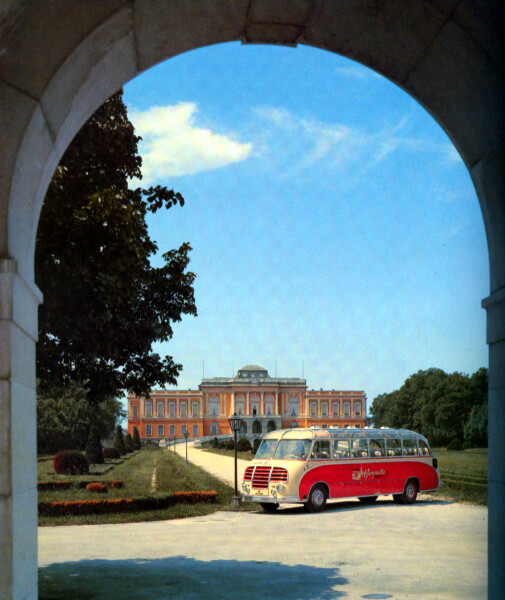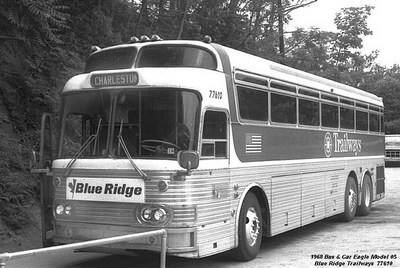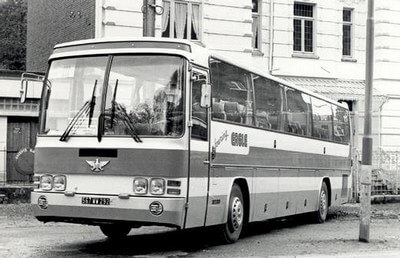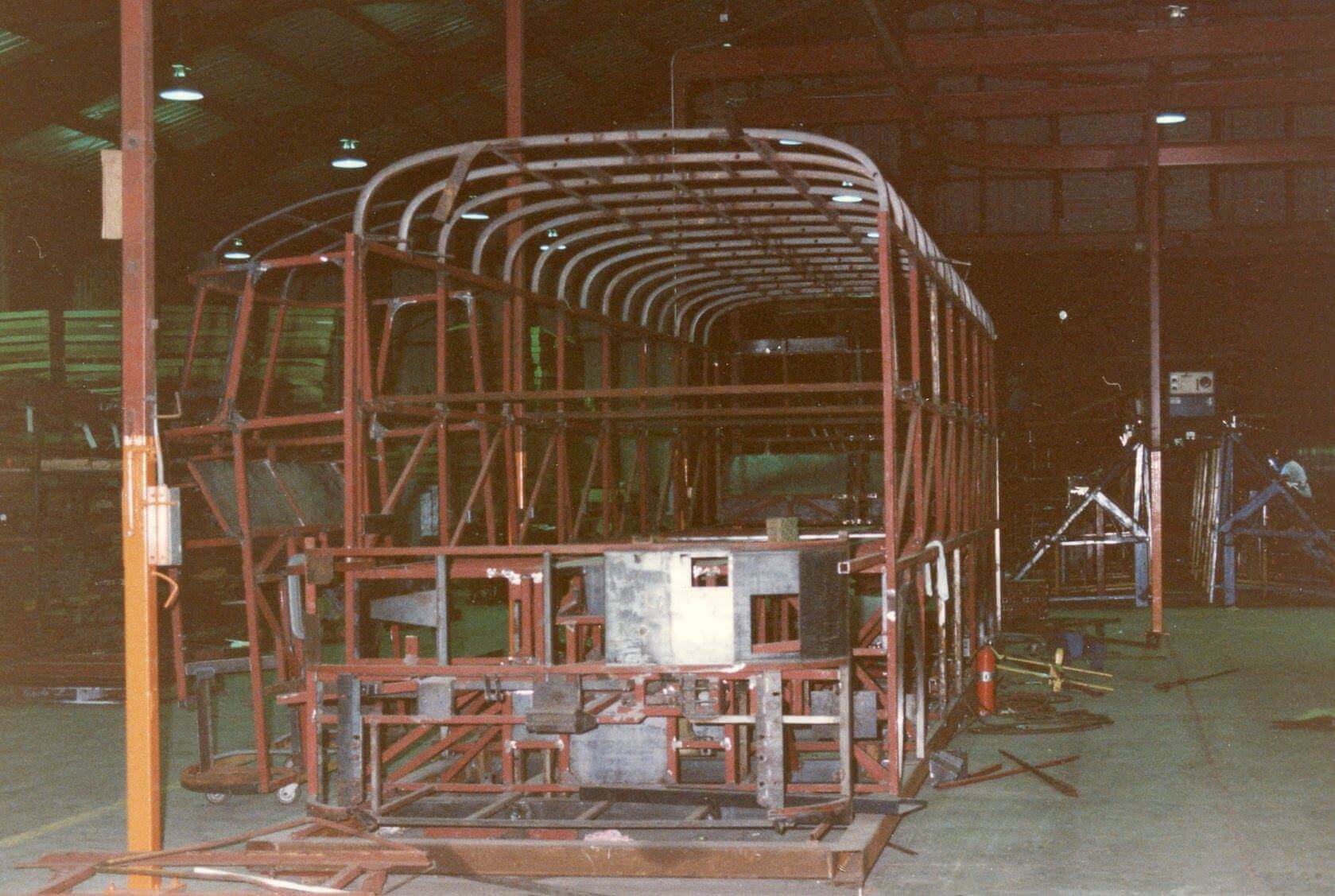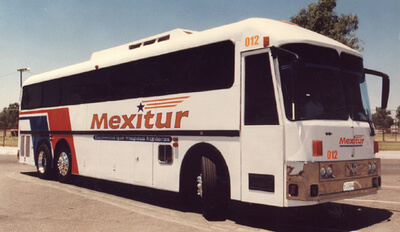In 1950, the demand for commercial vehicles was very high in Europe. At that time, buses and coaches shared chassis with trucks and vans. Since buses only accounted for about 10% of the chassis made, bus manufacturers didn’t have much control over the design or delivery of these chassis. Otto Kassbohrer & Georg Wahl of Kassbohrer Gmbh. designed a new chassis-less body, a self-supporting body frame, independent front suspension with rear engine drive. The new chassis-less frame was called Selbst Tragend (self-carrying). The bus was called “Setra” from the first letters of both words.
This first “Setra” bus was completed at the end of 1950. Its basic structure consisted of a load-bearing frame of a lattice pattern that is welded from high-quality section steel tubes & with sheet steel paneling making it absolutely rigid. It was tested for weeks over good and bad roads. The performance was so outstanding as to eclipse all previous buses. The coach shown was this first vehicle and remained in service for over 14 years and over 1 million kilometers.
The first Eagles Coaches were built in Germany by Kassbohrer in 1956. The Eagle coach was the result of a contract between Continental Trailways in the United States and the Karl Kassbohrer bus and coachbuilding firm in Germany. Continental Trailways was looking for something to compete with Greyhound’s Scenic Cruiser. Unable to find a North American manufacturer who would start production on their terms, Continental started looking overseas. Ireland was considered first, then England (Rolls Royce). Continental even considered buying Neoplan. Kassbohrer had the connections to M.A.N. for diesel motors and Z.F. for transmissions. Continental watched as Kassbohrer designed the new bus and approved every line on the new drawings. Continental acquired the “Eagle” Insignia from American Bus Lines which they had purchased.
Kassbohrer was the pioneer for articulated buses in Europe and their patented trailer had dominated the market for a decade or so. One result was the export in 1956 of two articulated coaches for Continental Trailways to the U.S.A., built on an “underfloor” Henschel Chassis with Kassbohrer bodywork and trailer. Also in 1956, Kassbohrer started building a high specification 40-foot 3-axle coach specifically designed for Continental Trailways.
In May 1957 President M.E. Moore of Continental Trailways visited the Kassbohrer factory. He is seen here with Otto Kassbohrer (in the picture) at a ceremony to name his new fleet. These Kassbohrer Setra Coaches were called “Golden Eagles”. Two hundred of these high-deck Eagle coaches were contracted.
Fifty coaches with M.A.N engines & Z.F. automatic transmissions were delivered in 1957 and the “Golden Eagle” coach was a success.
In 1958 a luxury high-deck version of the Setra articulated coach was supplied to the USA. This picture shows one of these vehicles on the Aichelberg, a steep and scenic section of the German Autobahn, during a test run. At least four of these 1958 Golden Eagles were delivered with this articulated design. They featured underfloor Rolls Royce engines and a Kassbohrer trailing section but had the same body design as the other Golden Eagles.
In 1958, 41 more Eagles were built by Kassbohrer. This factory run had a different specification. These were called “Silver Eagles” as the golden sides were changed to silver. The “Silver Eagle” design was standardized and Continental Trailways had the platform coach for their fleet.
In the late fifties, Kassbohrer announced its decision to concentrate more on the European market and decided to wind down the manufacturing of Eagle coaches for Trailways. Trailways found another European partner – La Brugeoise in Belgium, an old company mainly building railway equipment. La Brugeoise then produced coaches for one year until Continental established its own contractor in Belgium, giving it the name Bus & Car, N.V. Kassbohrer completed its run of the first Eagles in 1960.
In 1961, Bus & Car, N.V. built 185 Silver Eagles, Model 01’s of a somewhat different design. The first Bus & Car Eagles were similar to the earlier models except for the introduction of a wraparound mesh grill which remained an Eagle feature until 1969. Lower labor costs were the main reason to build coaches in Belgium but they still used many US components.
Bus & Car built the Model 01 until mid-1968.
In 1967 a prototype 2-axle “102” wide coach was built for Trailways, called the Model 02. Records later designated these 3 coaches as the Model 03
In addition to the coaches for the US market, Bus & Car developed other models. The Eagle 04 was a 2-axle coach for the European market and was manufactured from 1966-1970.
In late 1968, the new Model 05 was introduced. Late Model 01 and early Model 05 coaches have the same appearance. There were a number of internal changes but the main difference was the moving of the rear axle backward and placing the tag axle in front of the main axle.
One year later, Model 05 received a squarer appearance. Bus & Car produced this Model 05 for the US market until 1977, using mostly Detroit Diesel engines.
In 1969 and 1970, there was a run of 45 coaches of “102” width, these Model 07’s were delivered to various Trailways companies.
In 1972, Bus & Car built twenty Model 09 Eagles for South African Railways. These had the external appearance of the 05, but were shorter. Other exports of Model 05 look-alikes were made to Australia (24 coaches) and various European countries. In 1974 forty Eagle Model 14 buses were built for the Belgian Vicinal Railways (NMVB-SNCV, series 4285-4324), using Mercedes – Benz engines and SNCV’s standard body design. Another effort at building buses resulted in the delivery of fifteen Eagle 16s with Caterpillar engines to a Brussel’s public transport company, MIVB-STIB (series 8046-8060). While the design of these buses followed the standard Brussels model they featured “silver skirts” and a rather special windscreen.
U.S. production started in 1974 and In 1976, Bus & Car N.V. stopped producing Eagles for Trailways. By 1978, bus sales had dropped so much that the company got into financial trouble and was sold to MOL, a long-established Belgian builder of heavy machinery. MOL had built a small number of bus chassis and wanted to expand in this area. In total, Bus & Car N.V. built around 3,500 Eagles. 1,450 of these were Model 01 coaches.
MOL revised the Eagle range and added the production of a separate chassis for some models. At the bus show in Kortrijk, Belgium, in October 1979, several Eagles were shown by Eagle’s new owner. The coach pictured here was named the “Transcontinental”. It had several interesting features such as the large indicator lights on the front and the typical European low center door. It contrasted with another coach shown at the show (though outside the building) by having the arrangement with the tag axle leading the main axle and by having traditional rubber fitted windows.
A prototype transit bus which was somewhat reminiscent of the Brussels Eagle 16, called the “City”, and a coach named the “Touring”. This one had Spanish Irizar bodywork. Also in 1979, MOL built three small chassis with Cummins engines, the MOL Eagle M28, for Belgian Vicinal Railways for use on their Brugge city services (series 5559-5561). These received Jonckheere “Trans City” bodywork. In 1981-1982 a series of 25 bus chassis, MOL Eagle M31, was built for the Vicinal Railways for use around Gent (series 5715-5739). These had Mercedes engines and received Jonckheere A120 standard bodywork.
Apparently the “City” transit bus was demonstrated in the United States though no orders materialized. As a result of the depressed European market and strong competition, MOL only built 50 Eagle coaches between 1978 and 1987 when it closed its bus division.
Many U.S. parts were imported for assembly in Belgium, including Detroit Diesel engines and transmissions. Of the many running changes to the Model 01 during its lifetime, most were first seen in the 1964 models. Some were just appearance changes, but others were engineering, such as an air-operated parking brake and new air intakes for the engine. Most appearance features remained the same from 1965 through 1967 except that the silver siding and lightning bolt trim that was raised to the window level.
Rising labor costs in Belgium and a declining dollar resulted in the decision to shift production for the US market to the other side of the Atlantic. The Eagle International Incorporated factory started delivering buses made in Brownsville, Texas in 1974. For two years, both the “Bus & Car” and “Eagle” factories produced coaches for the US market, but since 1977, all US Eagles were produced in Texas. The Model 05 was built until 1980 when it was superseded by the Model 10 of which 2,217 were built until 1987. In 1982 a second factory was opened in Harlingen, Texas under the name Trailways Manufacturing Inc., to produce a 2-axle Model 10 Suburban (10S), which met with little success. The Harlingen plant also served as a refurbishment facility and production for some of the Greyhound Australia right-hand drive Model 10 coaches. In 1985 marketing began of the 102 inch wide Model 15. Finally, the Model 20 was introduced in 1987, which was basically a Model 10 with the external design of the Model 15 – i.e. a narrow Model 15 with a smaller engine. Externally it is difficult to distinguish the Model 15 and 20. Over the years, many smaller improvements were made and some companies ordered special versions of the standard models. For example, New Jersey Transit bought a special version of the Model 20, called AE-20, which had, among other features, large destination displays. In 1988, a 2-axle 35-foot version and a 3-axle 45-foot version of the Model 15 were introduced. In 1989, smooth sides became an option. The Eagle was also popular for motor homes and entertainer’s coaches. Nearly 4,000 Eagles have been built in Texas, mostly for the North American market, though some were exported to Australia, Chile, Egypt, Japan & Taiwan.
In 1987 Greyhound bought Trailways and Eagle International Inc. Greyhound Changed the name to Eagle Bus Manufacturing Inc. Greyhound filed for Chapter 11 bankruptcy in 1990 and as a subsidiary of Gryehound, Eagle Bus Manufacturing Inc. was forced to stop production in December of that year. In October 1991 the factory was sold to a Mexican corporation as Eagle Coach Coporation.
Bus production resumed in February 1992, but output remained low, with a large proportion of vehicles built as conversion shells for the entertainer market. By the end of the decade, the company got into trouble again and filed for Chapter 11 protection in the later part of 1997. The Eagle trademark and product line were purchased by Maplex, and activities were re-launched as Eagle Coach in August 1998 when some of the old facilities were leased from the City of Brownsville.
Some bus production continued at Groupo Ruvesa in Mexico – note smooth-sided Mexitur made in the state of Aguascalientes.
During its production of over four decades, some 8,000 Eagle coaches were built in four different countries on two continents and were the trademark of Continental Trailways for over three decades.
We want to thank John Veerkamp for his support, photos, and information.


